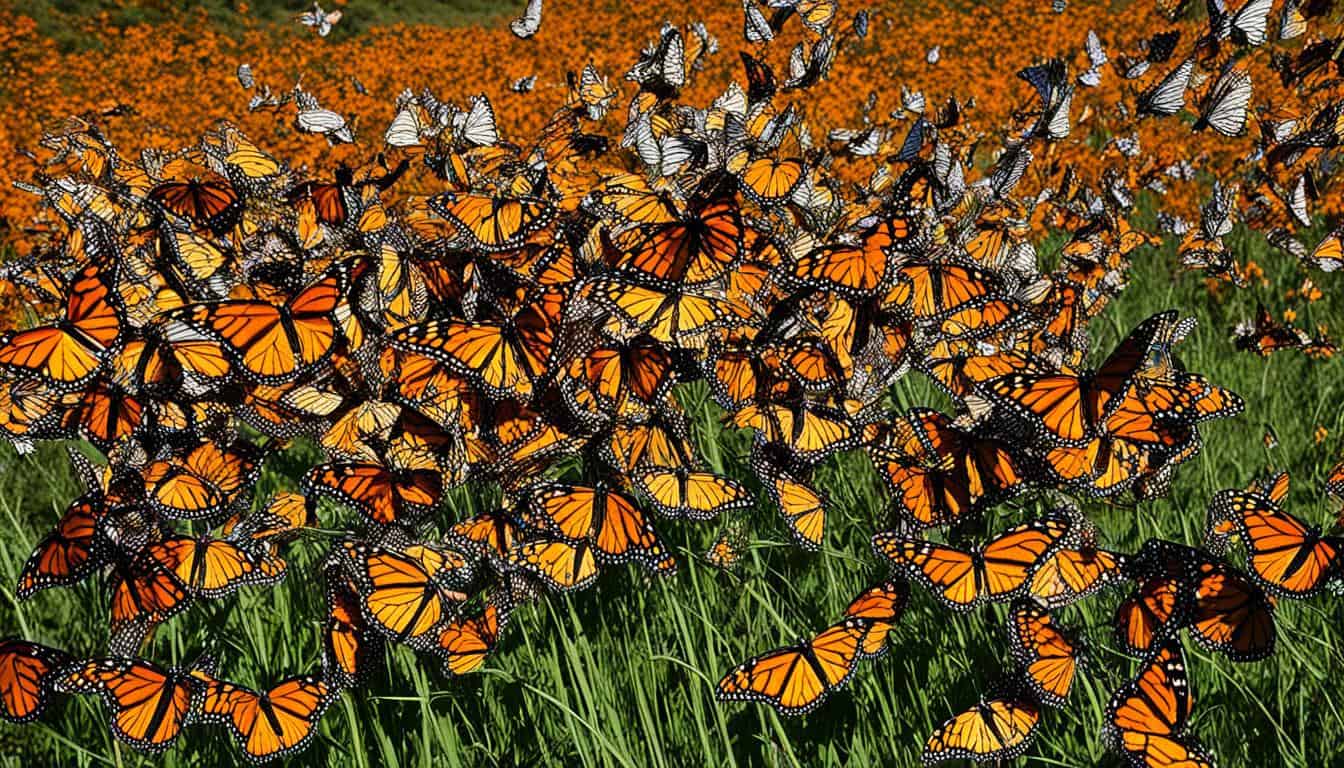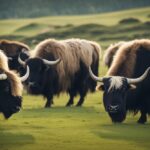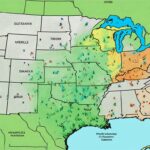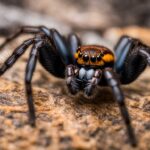Have you ever thought about how monarch butterflies make their incredible journeys? They fly thousands of miles to a special place for winter. This journey is one of nature’s most amazing events.
Every year, monarchs in North America travel great distances. Those east of the Rocky Mountains can go up to 3,000 miles to central Mexico. Meanwhile, those on the western side head to the California coast. It’s fascinating how they know when to leave, guided by environmental changes.
The journey to the California coast is a bit shorter. Yet, both groups of monarchs show incredible skills. They find their way to these winter spots, having never been there before. This shows how smart and strong the monarch butterflies are.
The Annual Journey of Monarch Butterflies
Watching the monarch butterfly migration is awe-inspiring. The butterflies take two main paths depending on where they are in relation to the Rocky Mountains. Each journey is full of challenges yet shows their incredible abilities.
Differences in Eastern and Western Migration Routes
Eastern monarchs fly a long way from the United States and southern Canada. They head to the mountains in central Mexico, flying up to 3,000 miles. They face many obstacles but show amazing strength. On the other hand, the western monarchs travel a shorter distance. They move from the California coast to inland spots for breeding. These differences in their paths reveal how adaptable and tough monarch butterflies are.
Factors Triggering Migration
Many things start the monarch butterfly migration. Less daylight and colder weather tell them it’s time to leave. Also, when milkweed and nectar plants are old, it’s harder to find food. So, these special signals push the monarchs to go in search of better places. In these new spots, they find more food and can live well.
Generational Patterns
Monarch butterfly migration is also special because of how they pass their journey down. The butterflies that travel can live a long life, up to nine months. They go to the overwintering sites and reproduce. Their children and grandchildren carry on the journey. This happens every year, showing their amazing will to keep going.
- Decreasing Daylight – Triggers migration start
- Temperature Changes – Prompts movement
- Aging Milkweed – Drives the search for new resources
- Generational Relay – Ensures continual migration
This migration shows how monarch butterflies and nature work together perfectly. It ensures the butterflies live on across the seasons.
The Eastern Monarch Migration Route
The eastern monarch migration is a stunning journey. It starts from the eastern United States and southern Canada. Monarch butterflies travel to central Mexico seeking warmer weather.
Starting from the Eastern US and Southern Canada
In early autumn, monarch butterflies move from the east to the south. They stop in places full of nectar to rest and refuel. This helps them keep their strength up for their long flight.
Traveling to Central Mexico
The monarch butterfly migration route includes an astonishing journey to central Mexico. Flying thousands of miles, they face many challenges. Yet, they are guided by their instincts and the environment during this route.
Overwintering in Oyamel Fir Forests
In central Mexico, they stay in the oyamel fir forests. These trees provide perfect conditions for the butterflies. This overwintering in oyamel fir forests is key for their survival.
As spring nears, they start moving back north. Their trip to Texas and other southern places restarts the breeding cycle, ensuring their life journey continues.
The Western Monarch Migration Route
The journey of the western monarch butterflies is awe-inspiring. They travel to and from various locations on a path unique to them, ensuring their species survives. Unlike their eastern cousins heading to Mexico, western monarchs fly along the Californian coast.
Migration Path to the California Coast
At first, the western monarchs begin their journey from inland grounds. They search for coastal areas filled with the right habitats and nectar. They travel long distances to reach the California coast.
Overwintering in Coastal Groves
In California’s coastal groves, the monarchs spend the winter. These groves offer a perfect climate that helps the monarchs save energy. They gather around eucalyptus and Monterey pine trees in large groups for safety.
This migration path shows how crucial coastal ecosystems are for western monarchs. They depend on certain trees and nectar plants for their survival during winter. In these groves, they slow down their life cycles and wait for spring. This strategy helps them live longer and be ready to start the cycle again with the coming of spring.
Monarch Butterfly Overwintering Sites
Each year, monarch butterflies choose special places to spend the winter. Their choices vary depending on where they come from. Western monarchs gather in trees along the California coast. This area’s warm weather helps them stay alive through winter.
Eastern monarchs head to the mountains of central Mexico instead. They pick oyamel fir forests. These places are cool, windy, and full of water. This special mix helps the monarchs save energy, which is a must to survive the cold.
The sites where monarch butterflies spend the winter offer more than just a place to stay. They also support life in unique ways. In California and Mexico, their chosen spots help many plants and animals thrive. This boosts the area’s natural variety. And it means the monarch butterflies can continue their incredible journey every year.
Triggering Factors for Monarch Butterfly Migration
The migration of monarch butterflies is an awe-inspiring event driven by specific cues. These signals mark the end of summer and the start of colder times. They prompt the butterflies to move, ensuring their survival.
Decreasing Day Length and Temperature
The monarch migration begins due to shorter days and cooler weather. As the climate changes, these butterflies know it’s time to journey. They move to better places before winter’s chill sets in.
Aging Milkweed and Nectar Sources
As the summer fades, milkweed dies and nectar gets scarce. This makes monarchs leave their homes to find cozy spaces for winter. By adapting to these changes, the monarchs survive the cold months.
Unique Behavioral Traits of Migratory Monarchs
The behavioral traits of migratory monarchs make them very different from non-migratory ones. Their long life is a key factor. They live up to nine months unlike many other insects. This long lifespan lets them migrate and survive during winter.
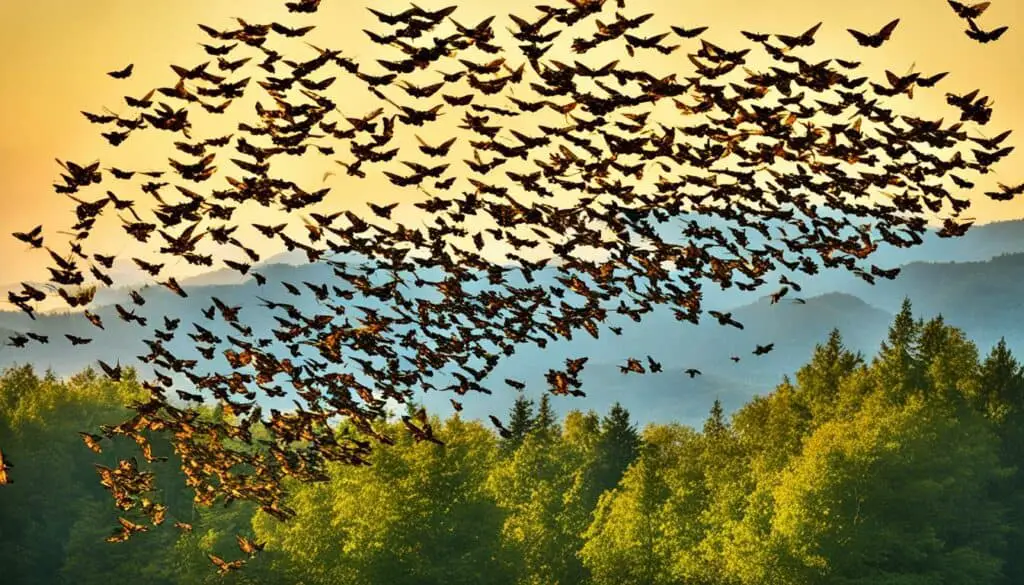
During their trip, these monarchs stop reproducing. This helps them use all their energy for traveling great distances. It’s impressive how nature has set this in motion, helping these butterflies survive their trips to winter.
Monarchs rely strongly on their instincts. They find their way to places they’ve never been before. Their ability to locate the exact spots for wintering shows the amazing power of their natural, engrained skills.
| Behavioral Trait | Description | Relevance |
|---|---|---|
| Extended Lifespan | Migratory monarchs live up to nine months | Allows for long-distance travel and overwintering |
| Reproductive Diapause | Reproduction is halted during migration | Focuses energy on travel and survival |
| Inherited Navigation | Instinctual travel to traditional overwintering sites | Ensures continuity of migration patterns |
Monarch butterfly migration facts help us see their great strength and the details of their life. The special behaviors of these monarchs show us how they make such big journeys with careful planning.
Navigational Cues Used by Monarch Butterflies
Monarch butterflies show amazing skills in finding their way on long flights. They have several tools to help them fly across long distances.
The Role of the Sun Compass
The sun is a key guide for these butterflies. They look at where the sun is and also use an internal clock. This helps them fly straight over long journeys.
Magnetic Compass Utilization
If it’s cloudy and they can’t see the sun, monarchs have a backup plan. They use a magnetic compass. It lets them feel the Earth’s magnetic field and keeps them flying in the right direction.
Inherited Genetic Instincts
Not just the sun or the magnetic compass, monarchs’ genes also play a big role. Studies show they have genes specifically for migration. These genes help them find the right places to rest, even on their first trip there.
Challenges Faced During Monarch Migration
Monarch butterflies journey thousands of miles twice a year. Yet, their path is filled with dangers. Understanding these challenges highlights the need to protect these amazing insects.
Predators and Natural Hazards
Monarchs face dangers from predators like birds and small mammals. These creatures hunt them as food, lowering their numbers. They also deal with natural threats such as storms and winds, which can harm whole groups.
Mountains and large waters are big challenges too, needing a lot of energy to cross. These obstacles can be very dangerous for the delicate butterflies.
Environmental Threats
The dangers for monarchs are made worse by their changing environment. Loss of homes because of farming and cities takes away their food and places to breed.
Climate change confuses their journey by changing when food is available. Pesticides harm the plants monarchs need to live. This puts their whole population in danger, urging us to safeguard their future.
FAQ
What are the migration patterns of monarch butterflies?
Monarch butterflies have known migration patterns. They travel from their summer areas to specific winter locations. Eastern monarchs head as far as 3,000 miles to central Mexico. Meanwhile, western monarchs go to the California coast, a shorter journey.
What is the annual journey of monarch butterflies like?
The journey happens every year, guided by nature’s signals. Monarchs from east to west have their own routes, covering different paths and distances. Yet, they all play a part in a special migration relay.
What are the differences in Eastern and Western monarch migration routes?
Eastern monarchs fly from the east and south of the U.S. to Mexico. Western monarchs go from California inland. The Rocky Mountains help shape their different paths.
What factors trigger monarch butterfly migration?
The need for migrating comes from shorter days, cooler weather, old milkweed, and less nectar. These signs tell monarchs it’s time to move to their winter homes.
How do monarchs exhibit generational patterns during migration?
Monarchs show a unique relay with each generation taking the journey forward. The longer-lived migratory generation plays a crucial role. It lasts up to nine months, covering the whole migration cycle.
Where do Eastern monarch butterflies start their migration?
Eastern monarchs start in the eastern U.S. and Canada, heading south. They stop at various sites on their way to Mexico.
Where do Eastern monarch butterflies travel for overwintering?
To survive the winter, eastern monarchs gather in central Mexico. They prefer the oyamel fir forests for the cool climate and protection.
What is unique about the overwintering sites in oyamel fir forests?
The oyamel fir forests provide ideal conditions for survival. They offer cool weather, water, and predator protection. This helps monarchs save their energy for the upcoming journey.
What is the migration path of Western monarch butterflies?
Western monarchs move from the California coast inland during spring. They search for milkweed to lay eggs. In the fall, they return to coastal trees like eucalyptus and Monterey pines to survive the winter.
Where do Western monarch butterflies overwinter?
In the winter, western monarchs cluster in groves along the California coast. This area is loved for its mild weather and rich nectar plants.
What are the key overwintering sites for monarch butterflies?
For winter, western monarchs favor groves along the California coast. Eastern monarchs choose the oyamel fir forests in Mexico. Both places offer what the butterflies need to make it through winter.
How do decreasing day length and temperature trigger monarch migration?
The change in seasons brings shorter days and cooler weather. This tells monarchs it’s time to move towards the warmer overwintering areas.
How do aging milkweed and nectar sources influence monarch migration?
With less fresh food, monarchs leave their homes to find a better place. This ensures they can survive during the winter.
What are unique behavioral traits of migratory monarch butterflies?
Migratory monaches live longer compared to non-migratory ones and have a different focus. They don’t reproduce but ensure their travel is guided by an instinctive sense of direction.
What navigational cues do monarch butterflies use?
Monarchs use different tools to find their way, like the sun’s position, Earth’s magnetic field, and an inherited sense of direction. This helps them fly their migration route.
What challenges do monarch butterflies face during migration?
Monarchs encounter a lot of risks during migration. These include being hunted by predators, facing storms and water bodies, and threats from human actions like habitat destruction and pollution.
What environmental threats impact monarch migration?
Big dangers to monarchs include losing their homes, changes in weather, and harmful chemicals. These issues make it hard for them to find food and a safe place to live.

